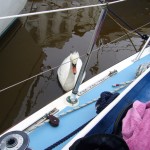
This gallery contains 56 photos.
A selection of pics from the our trip to the Isle of Man in 2009.

We’ve always had trouble going astern in Tiffane. She just doesn’t respond, even stopping is very difficult. We had the prop checked last year but it wasn’t worn or slipping. However, it was a very small 2-bladed job, more suitable for a small petrol engine.
This year we therefore decided to replace it, but unfortunately the new one hadn’t arrived by launch day. So this week-end we beached her and the engineer replaced it.
Beaching in Conwy river is very easy, there are so many mud banks to choose from! As there was quite a breeze blowing (3 gusting 5 in the river, 4 gusting 6 out at sea), we went for the upwind shore – trickier to do the beaching but trivial to get her back off again.
The bad news is that although she performs better, the problem isn’t fixed. I personally think the gearbox is slipping so that’s another job…
We launched late this year, mainly due to being pretty busy at work earlier in the year. While she was out of the water in 2008 / 2009 we had all four chainplates replaced as one was showing signs of raising up. We also replaced another section of the cockpit (Starboard side) where the seat support had collapsed, which involved removing the aft Starboard locker lid. I suspect the Port one will need replacing in the next few years.

This gallery contains 25 photos.
Finally, after all the years of hard work, she floats! We had a fantastic sail across from Bangor to Conwy as our first short trip, only marred by some evil slamming waves (wind against tide) on the entrance to Conwy … Continue reading
The new cockpit floor is in, with two drains in the corners rather than a single drain in the middle. The floor was partially painted before fitting and thickened epoxy was used to bed it in.
I serviced the winches and in doing this discovered that the base of one had corroded away around one of its fixing bolts. I considered fitting a new winch but they are expensive, so instead I drilled a new hole in the winch baseplate and found that the rest of the base was sound metal, so I was happy with the repair.
A new exhaust system and new batteries have been fitted. The electrical system is now operational and tested once again, although work in future years will include a re-wire. The cockpit floor, which was rotten all around the edges, has been replaced, and the single cockpit drain replaced with a drain on either side to improve drainage while heeling. One of the cockpit locker lids has been replaced, all the cockpit locker surrounds have been epoxied to make them watertight, the cockpit side panels have been replaced and the cockpit locker lids have had toggle catches fitted. Finally, the entire cockpit has been sanded ready for painting.
The aft bulkhead is fully fitted and painted and the galley, engine controls and battery switch are back in. A new stop cable has been fitted to the engine. The engine access hatch has been revamped, with lovely new Southco twist-catches fitted, which ensure a watertight seal around the hatch.
We discovered that the bilge pump, although operational, was literally held together with Sikaflex, and pulling at one of the hoses separated it from the pump. We discovered that the fitting had sheared from the pump and sikaflex had been used to stick it back on.
Hmmm. New bilge pump and hoses fitted, and while we were at it, a new diverter valve to select the bilge to be pumped. Couldn’t do much else this month, as we had lots of other stuff on.
The port section is now completely fitted, the centre section is mostly fitted, but more ‘glassing’ will be done to finish it off. Painting of the starboard section has begun.
The Starboard section of the aft bulkhead is ‘glassed’ in. Actually I’ve started using a combination of ribbon and epoxy instead of fibre and resin – Much easier to work with, no odour, and considerably stronger. Marine epoxy is also multi-use and as well as structural repairs it can be used for gap filling, crack filling, fairing and gluing, amongst other things. There are additives for all these jobs and it’s up to the user how much additive to mix in, giving different consistencies. Although they are expensive, invest in the correct mixing syringes / pumps as they ensure the correct proportion of resin to hardener and make mixing up many batches a breeze.